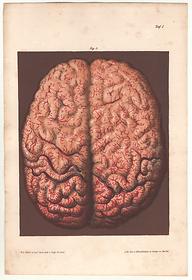Exhibition Images
Image 18 of 43
Upon a View of the Body
Brain hypostasis, 1864
Fig. 1. Brain Hypostasis not hyperemia. Hyrnhypostase, nicht Hirnhyper�mie. Hypostasis: poor or stagnant circulation in a dependent part of the body or organ. Hyperemia: an excess of blood in a part, engorgement. (Hyrn = brain)
Brain of an 18-year-old man, drawn 26 hours after his death in June at an air temperature of 15° R (C?). This is the brain of a man who died from tuberculosis of the lung after a long consumptive fever. The corpse which right after death was taken to the hospital morgue was still fresh at the time the drawing was made and only the first lightly green spots on the abdominal wall were visible. The obduction (medico-legal autopsy) apart, the findings about the lung yielded as was to be expected a general anemia of the whole body to a high degree, and that is precisely the reason why this specimen of brain hypostasy was chosen to illustrate the diagnosis of brain hyperamy. The hypostasy was found at the back of the head as is expected in all cases where the corpse was positioned on its back.
Brain of an 18-year-old man, drawn 26 hours after his death in June at an air temperature of 15° R (C?). This is the brain of a man who died from tuberculosis of the lung after a long consumptive fever. The corpse which right after death was taken to the hospital morgue was still fresh at the time the drawing was made and only the first lightly green spots on the abdominal wall were visible. The obduction (medico-legal autopsy) apart, the findings about the lung yielded as was to be expected a general anemia of the whole body to a high degree, and that is precisely the reason why this specimen of brain hypostasy was chosen to illustrate the diagnosis of brain hyperamy. The hypostasy was found at the back of the head as is expected in all cases where the corpse was positioned on its back.
Johann Ludwig Casper, M.D., Atlas zum Handbuch der gerichtlichen Medicin [Atlas for the Manual of Legal Medicine], (4th ed., Berlin, 1864) [chromolithograph]; Artist: Hugo Troschel; Lithographer: Winckelmann & Sons
National Library of Medicine
